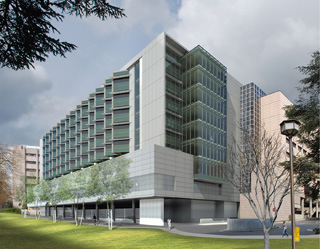|
Subscribe / Renew |
|
|
Contact Us |
|
| ► Subscribe to our Free Weekly Newsletter | |
| home | Welcome, sign in or click here to subscribe. | login |
Construction
| |
 |
June 23, 2011
Study will help UW’s Montlake Tower cut energy costs
NBBJ

Griffin
|
When the Montlake Tower opens at the University of Washington Medical Center in the fall of 2012, it will become one of the most energy-efficient hospital additions in the Northwest, outperforming Seattle’s energy code by approximately 30 percent and the national baseline code by an estimated 33 percent.
The need for health care projects such as the Montlake Tower is obvious. Research shows hospitals are the second most energy-intensive building type on the planet. Studies also show that health care employees, who often work long shifts in spaces divorced from daylight, face a higher than average risk for asthma and other respiratory diseases. Reducing energy use helps patients, providers and the planet.
Unfortunately, health care organizations that are interested in greening their facilities are often reluctant to do so because of perceived risks associated with infrastructure changes. This concern, along with a desire to profoundly lower carbon emissions, led to an ongoing energy-reduction study by the University of Washington’s Integrated Design Lab, NBBJ, TBD Consultants, Solarc Architecture and Engineering, Cameron MacAllister Group, Mahlum Architects and Mortenson Construction.
Though still under way, the study has already pinpointed design solutions that can be immediately carried out to reduce energy use. You can view a summary of the study and the results online at bit.ly/laXkXa.
The heart of the research focuses on mechanical systems and procedures that typically use the most energy, including the reheating of centrally cooled air. This process alone represents a staggering 40 percent of an average hospital’s energy. The study also found significant savings can be realized by addressing solar and daylight shading controls, in-room environmental tempering and access to natural daylight.
The UW’s Montlake Tower is the first to implement some of the strategies discovered in the study.
Energy-reduction strategies
So how did the project team design the facility to achieve such dramatic energy reduction?
First we looked at ways to reduce building loads imposed by solar orientation. For example, we took the building site alignment required by very limited constraints and reoriented the patient rooms to face south. Not only did this reduce the energy required to power the facility, it also had the benefit of improving views from patient rooms, now looking toward Mount Rainier and the Cascade Mountains.
Once we coupled reorientation of the patient room with solar shading, we created comfort conditions in the patient room that lowered the building mechanical requirements. Other energy-efficient strategies employed on the Montlake project include heat-recovery chillers, LEDs for lighting in patient rooms and occupancy sensors in other areas, leading to reduced air conditioning and lighting in unoccupied rooms.
The Montlake Tower is expected to operate with an Energy Use Index of approximately 150 and save the client up to $200,000 in annual energy costs. This is an unprecedented accomplishment for a medical center and research hospital of this size and scope.
It’s important to note these strategies are not necessarily new, just new to standard hospital design. It is also imperative to mention these strategies are most effective when they are bundled together.
Throughout the study, we realized significant energy savings are only possible through close partnerships. Specifically, we found it essential to collaborate from the earliest stages of planning with design, construction, public utility and facility operation team members.
Nationwide model
Last year, our team was awarded part of a $1.2 million grant by the U.S. Department of Energy to take our initial findings and build a nationwide model for reducing energy across six climate zones, including those around New York, Houston, Chicago, Phoenix, Los Angeles and Seattle. We anticipate our next phase of research will lend itself to significant energy reduction in not only these locations, but other areas across the globe with hospitals in similar climate zones.
Meantime, research partners continue to work to implement part or all of the study’s strategies from what we’ve learned so far. For instance, NBBJ has begun work on an 850,000-square-foot acute care hospital in the Midwest that is slated to achieve a 60 percent energy reduction when it opens in 2015.
As we move forward with our research and continue to build a portfolio of successful projects, we anticipate these integrated strategies will become more and more mainstream, eliminating the fear of unknown risks and validating the expected benefits. Hospitals are an essential community resource and this study offers a way to keep these critical enterprises viable by cutting bottom-line costs and improving patient and staff environments.
Duncan Griffin is a principal at NBBJ, a global architecture, planning and design firm with offices in North America, Europe and Asia.
Other Stories:
- 13 tips for choosing your medical space
- Swedish Issaquah aligns design with patient needs
- Good signage points the way to better health care
- 'Novel' process lets Swedish Issaquah hit fast forward
- ‘Hybrid’ rooms a low-cost answer to space needs
- Swedish women’s cancer center a one-stop shop
- Group Health is designing its clinic of the future
- Puyallup hospital tower puts focus on patients
- Evergreen opens center closer to its patients
- New VA complex to treat ‘emerging’ war injuries
- Friday Harbor hospital aims to be nation’s greenest
- UW expansion stays on track despite big change in plans



